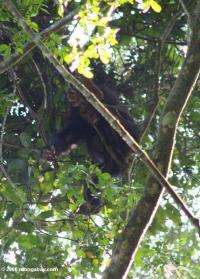April 15, 2009 weblog
Anthropologist Says Tree Climbing Abilities of Early Hominins Decreased Rapidly in Evolutionary Process

Jeremy M. DeSilva an anthropologist at Worcester University in Massachusetts has published "Functional Morphology of the Ankle and the Likelihood of Climbing in Early Hominins," in the peer-reviewed journal, Proceeding of the National Academies of Sciences of the USA current issue. The study includes data gathered by DeSilva in Uganda's Kibale National Park of modern chimpanzee and comparisons of hominin fossil skeletal remains dating back some 4.12 million to 1.53 million years ago. The findings appear to show that if early hominins depended on tree climbing as part of their survival repertoire, they were performing it decidedly different from modern chimpanzee locomotor activity.
Most human evolution researchers agree that at some point in history, estimated to be about 5 million to 7 million years ago the chimpanzee and human like species proceeded on a different evolutionary path. The question DeSilva addresses is whether early man's adaptation to full bipedalism involved a swift shedding of the ability to climb and swing from trees. DeSilva compared the great apes and early hominin ankle joint, the tibia and the talus in the foot. He discovered marked differences between the structure and capacity of these two skeletal fossils.
DeSilva observed and filmed Uganda's modern chimps tree climbing and tree swinging activity. He discovered that modern chimpanzees when pushing off from a tree branch flex their ankles, thereby raising their foot some 45 degrees. Modern man generally flexes his ankle only 15 to 20 degrees while walking and suffers injury if stretched any further. It goes without saying, there are certain super modern athletes who can flex the ankle without injury.
In effect, DeSilva points to an important evolutionary divide, wherein early hominin may have foregone his natural tree climbing, ankle flexing capacity in order to walk upright. His examination of early hominin and the great ape indicates the evolutionary morphing took place very rapidly. His review of early hominin and the great ape demonstrate the ankle joint differences took place early in the evolutionary cycle.
According to ScienceNow reporter Michael Baiter in his article, "Our Ancestors Were No Swingers", David Begum, a paleoanthropologist at the University of Toronto in Canada points to early hominins ability to scramble up a tree for safety which would not have involved or required the full 45 degree ankle flex exhibited by modern chimpanzees.
The DeSilva study agrees with its critics. He concludes that if early hominins included tree climbing as part of their survival skill set, they were performing it very differently than modern chimpanzees.
Sources:
PNAS, April 13, 2009, www.pnas.org/content/early/200 … /0900270106.abstract
Science Now, April 13, 2009, sciencenow.sciencemag.org/cgi/ … tent/full/2009/413/2
© 2009 PhysOrg.com















